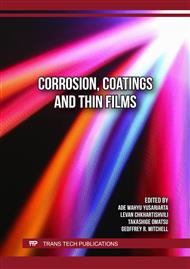p.47
p.55
p.67
p.73
p.79
p.89
p.97
p.105
p.111
Investigation of the Optoelectronic Properties of Polyimide Films and Research on Tunable Bandgap through Fabrication Processes
Abstract:
Our laboratory explores organic polymer materials, focusing on utilizing polyimide (PI) films [1] as the resistive switching layer in resistive random-access memory (ReRAM). This study investigates how UV-induced molecular changes in PI films lead to resistance transitions resembling electrical switching. Based on this characteristic, a novel resistive optoelectronic memory device has been developed and explores methods for tuning their energy gap (Eg) through process modifications. By analyzing the physical and electrical properties of the films, we evaluate their UV absorption efficiency and molecular structural transformations. The study identifies the optimal UV wavelength for operation and measures device programming efficiency and data retention. Finally, through process control to modulate the energy gap of PI films.
Info:
Periodical:
Pages:
89-95
Citation:
Online since:
October 2025
Price:
Сopyright:
© 2025 Trans Tech Publications Ltd. All Rights Reserved
Share:
Citation:


